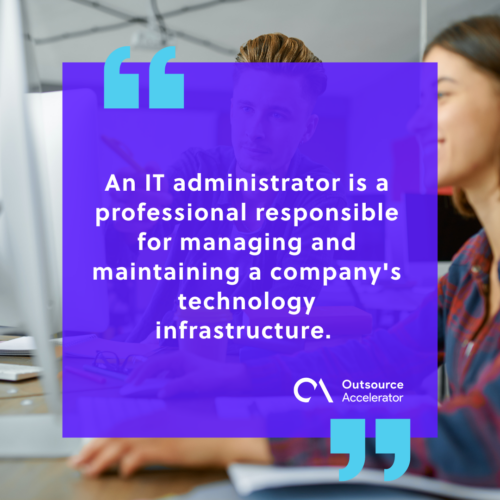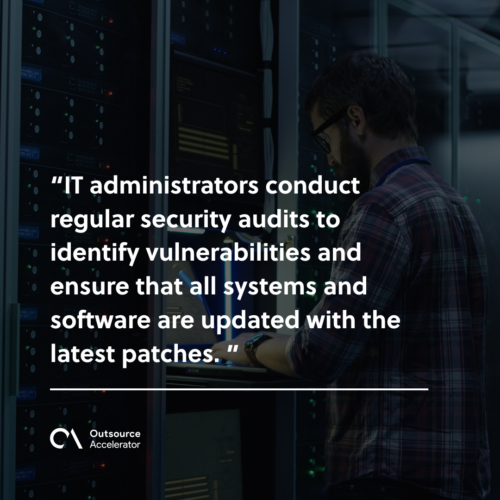How an IT administrator ensures seamless operations

Technology roles are akin to the backbone of an organization’s digital infrastructure.
They ensure the seamless operation of an organization’s IT systems, networks, and data, safeguarding it from the constant threats that lurk in the virtual realm.
Their contribution is even increasingly appreciated, as shown by the trajectory of their roles. Data from Bureau of Labor Statistics (BLS) stated that technology roles are expected to grow faster than most occupations by 2032.
At first glance, the title “IT administrator” may seem rather straightforward. However, it encompasses a broad range of responsibilities and expertise.
IT administrators are the architects and custodians of an organization’s technological ecosystem. They are entrusted with the crucial task of keeping the digital gears turning smoothly.
Explore the responsibilities and skills of IT administrators and how they contribute to seamless operations in an organization.
What is an IT administrator?
An IT administrator is a professional responsible for managing and maintaining a company’s technology infrastructure.
IT administrators ensure that all systems and networks function properly, resolve technical issues, and prevent any that may arise.

An IT administrator’s duties and responsibilities
An IT administrator accomplishes various duties and responsibilities, such as the following:
System maintenance and upkeep
One of the primary responsibilities of IT administrators is to ensure the smooth functioning of the organization’s computer systems.
Along with the system administrator, they are tasked to optimize computer systems and maintain their tip-top performance. This includes managing software updates, maintaining hardware and software inventories, and performing regular backups.
Maintaining network security
IT administrators are key players in safeguarding an organization’s network against security threats.
They apply security measures such as firewalls and antivirus systems to protect the network from external threats. In addition, they help implement effective security systems for their client’s operations as needed.
IT administrators also play a huge part when conducting security risk assessments. They monitor network traffic and investigate suspicious activities to prevent and mitigate potential breaches.
User support and training
IT administrators also provide user support and training to ensure employees can utilize technology effectively. They troubleshoot hardware and software issues, assist users with technical problems, and provide training on new applications or systems.
IT administrators empower employees to leverage technology in their everyday tasks by offering timely assistance and valuable training.
Ensuring business continuity
Lastly, an IT administrator is a key player in business continuity management. These plans outline procedures and strategies to recover data and resume operations swiftly in the event of a disaster or unforeseen circumstances.
Essential skills of an IT administrator:
To excel in their role, IT administrators must possess diverse skills, including
Technical expertise
IT administrators are experts in computer science. They can handle the majority of the company’s computer infrastructure, from user accounts to network security.
With this, IT administrators must deeply understand computer hardware, software, and networks. They should be proficient in operating systems, programming languages, and network protocols.
Problem-solving
IT administrators must be skilled in troubleshooting technical issues. They should possess strong analytical abilities to identify problems and quickly find effective solutions.
Attention to detail
IT administrators need to be meticulous and detail-oriented. They must carefully review system logs, security alerts, and other data to identify and proactively address potential issues.
Time management
IT administrators often face tight deadlines and competing priorities. This is a crucial part of their project management duties, whether for the company or their clients.
They must possess excellent time management skills to handle multiple tasks and resolve critical issues promptly and efficiently.
How an IT administrator ensures seamless operations
IT administrators employ various strategies and practices to help you ensure seamless operations.
Here are some of these practices:
Proactive monitoring and maintenance
IT administrators continuously monitor systems and networks to detect potential issues before they impact operations.
They use monitoring tools to keep track of system performance, network traffic, and security events, allowing them to identify and address any anomalies promptly.
Regular security audits and updates
IT administrators conduct regular security audits to identify vulnerabilities and ensure that all systems and software are updated with the latest patches.
By proactively addressing security concerns, they minimize the risk of cyber-attacks and data breaches. They collaborate with relevant teams to patch vulnerabilities and implement security controls to mitigate potential risks.

Automation processes
IT administrators leverage automation tools and technologies to streamline processes and reduce manual intervention.
By automating routine tasks and implementing workflow optimization, they increase efficiency and minimize the chance of human error that could disrupt operations.
For example, an IT administrator may automate software deployment processes, ensuring all employees have the necessary applications without manual installation.
Continual learning and adaptation
IT administrators understand the importance of staying abreast of industry trends and technologies. They continually invest in professional development to acquire new skills and adapt to evolving IT landscapes.
For instance, they may attend industry conferences or relevant webinars to expand their knowledge of emerging technologies such as cloud computing or artificial intelligence.
Hiring an IT administrator
Hiring a qualified IT administrator is crucial in maintaining a smooth and productive technology infrastructure.
With this, organizations should consider various factors, such as the following:
- Look for candidates with a proven track record in managing complex IT systems and networks.
- Consider candidates with relevant certifications, such as Cisco Certified Network Associate (CCNA).
- Choose candidates willing to learn and adapt to new technologies and industry trends.
By carefully considering these factors, organizations can hire IT administrators who will contribute to seamless operations. They will play a crucial role in the organization’s technological success.







 Independent
Independent




